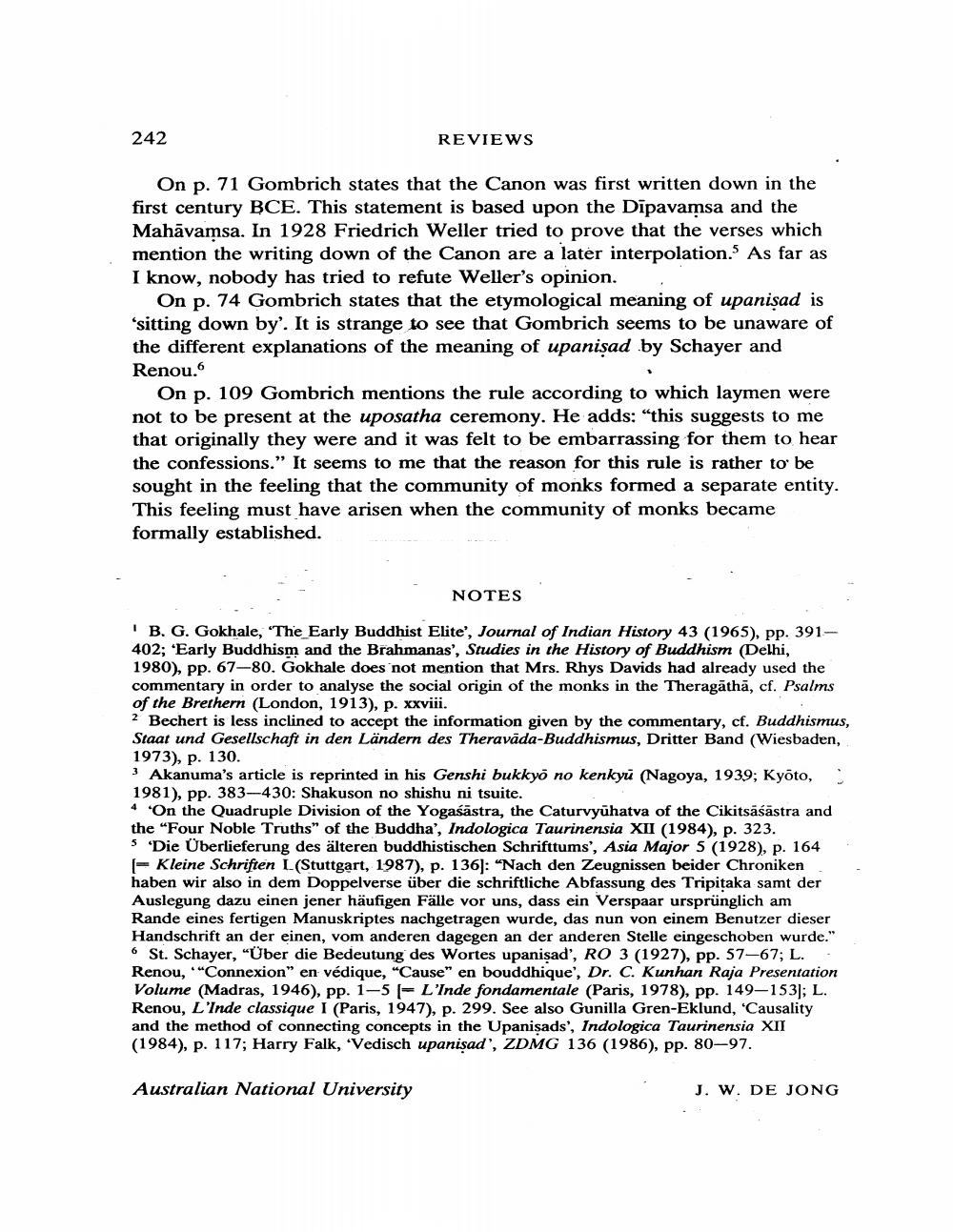________________
242
REVIEWS
On p. 71 Gombrich states that the Canon was first written down in the first century BCE. This statement is based upon the Dīpavamsa and the Mahāvamsa. In 1928 Friedrich Weller tried to prove that the verses which mention the writing down of the Canon are a later interpolation. As far as I know, nobody has tried to refute Weller's opinion.
On p. 74 Gombrich states that the etymological meaning of upanişad is 'sitting down by'. It is strange to see that Gombrich seems to be unaware of the different explanations of the meaning of upanişad by Schayer and Renou.
On p. 109 Gombrich mentions the rule according to which laymen were not to be present at the uposatha ceremony. He adds: “this suggests to me that originally they were and it was felt to be embarrassing for them to hear the confessions." It seems to me that the reason for this rule is rather to be sought in the feeling that the community of monks formed a separate entity. This feeling must have arisen when the community of monks became formally established.
NOTES
IB. G. Gokhale. "The Early Buddhist Elite', Journal of Indian History 43 (1965), pp. 391402; 'Early Buddhism and the Brahmanas', Studies in the History of Buddhism (Delhi, 1980), pp. 67-80. Gokhale does not mention that Mrs. Rhys Davids had already used the commentary in order to analyse the social origin of the monks in the Theragāthā, cf. Psalms of the Brethern (London, 1913), p. xxviii. 2 Bechert is less inclined to accept the information given by the commentary, cf. Buddhismus, Staat und Gesellschaft in den Ländern des Theravāda-Buddhismus, Dritter Band (Wiesbaden, 1973), p. 130. 3 Akanuma's article is reprinted in his Genshi bukkyo no kenkyu (Nagoya, 1939; Kyoto, 1981), pp. 383-430: Shakuson no shishu ni tsuite. 4 'On the Quadruple Division of the Yogaśāstra, the Caturvyuhatva of the Cikitsasastra and the "Four Noble Truths" of the Buddha', Indologica Taurinensia XII (1984), p. 323. 5 'Die Überlieferung des älteren buddhistischen Schrifttums', Asia Major 5 (1928), p. 164
- Kleine Schriften L(Stuttgart, 1987), p. 136): "Nach den Zeugnissen beider Chroniken haben wir also in dem Doppelverse über die schriftliche Abfassung des Tripitaka samt der Auslegung dazu einen jener häufigen Fälle vor uns, dass ein Verspaar ursprünglich am Rande eines fertigen Manuskriptes nachgetragen wurde, das nun von einem Benutzer dieser Handschrift an der einen, vom anderen dagegen an der anderen Stelle eingeschoben wurde." 6 St. Schayer, "Über die Bedeutung des Wortes upanisad', RO 3 (1927), pp. 57–67; L. Renou,"Connexion" en védique, "Cause" en bouddhique', Dr. C. Kunhan Raja Presentation Volume (Madras, 1946), pp. 1-5 - L'Inde fondamentale (Paris, 1978), pp. 149–153); L. Renou, L'Inde classique I (Paris, 1947), p. 299. See also Gunilla Gren-Eklund, 'Causality and the method of connecting concepts in the Upanisads', Indologica Taurinensia XII (1984), p. 117; Harry Falk, 'Vedisch upanişad', ZDMG 136 (1986), pp. 80-97.
Australian National University
J. W. DE JONG




